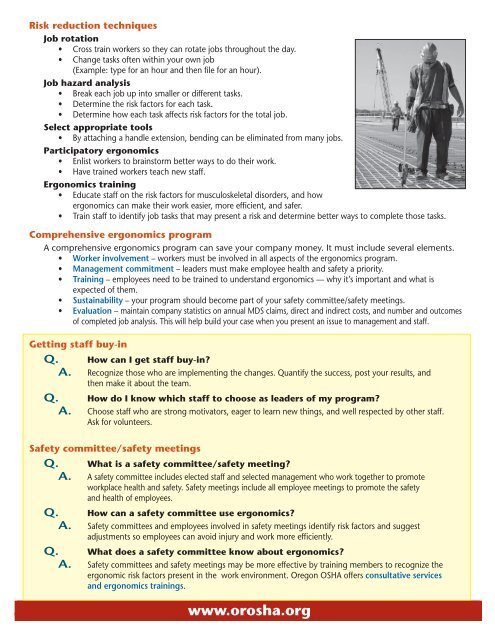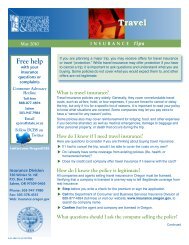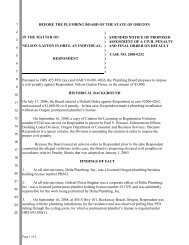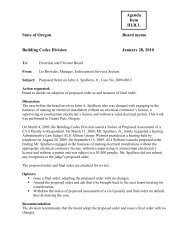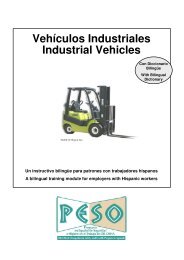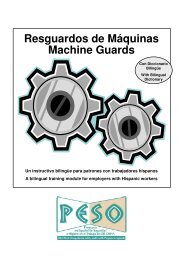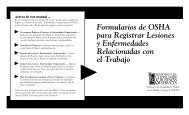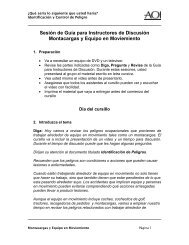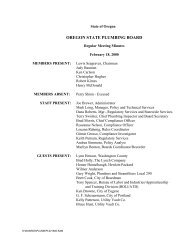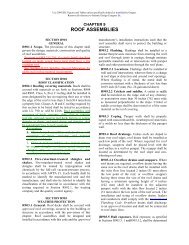The Advantages of Ergonomics
The Advantages of Ergonomics
The Advantages of Ergonomics
You also want an ePaper? Increase the reach of your titles
YUMPU automatically turns print PDFs into web optimized ePapers that Google loves.
Risk reduction techniques<br />
Job rotation<br />
• Cross train workers so they can rotate jobs throughout the day.<br />
• Change tasks <strong>of</strong>ten within your own job<br />
(Example: type for an hour and then file for an hour).<br />
Job hazard analysis<br />
• Break each job up into smaller or different tasks.<br />
• Determine the risk factors for each task.<br />
• Determine how each task affects risk factors for the total job.<br />
Select appropriate tools<br />
• By attaching a handle extension, bending can be eliminated from many jobs.<br />
Participatory ergonomics<br />
• Enlist workers to brainstorm better ways to do their work.<br />
• Have trained workers teach new staff.<br />
<strong>Ergonomics</strong> training<br />
• Educate staff on the risk factors for musculoskeletal disorders, and how<br />
ergonomics can make their work easier, more efficient, and safer.<br />
• Train staff to identify job tasks that may present a risk and determine better ways to complete those tasks.<br />
Comprehensive ergonomics program<br />
A comprehensive ergonomics program can save your company money. It must include several elements.<br />
• Worker involvement – workers must be involved in all aspects <strong>of</strong> the ergonomics program.<br />
• Management commitment – leaders must make employee health and safety a priority.<br />
• Training – employees need to be trained to understand ergonomics — why it’s important and what is<br />
expected <strong>of</strong> them.<br />
• Sustainability – your program should become part <strong>of</strong> your safety committee/safety meetings.<br />
• Evaluation – maintain company statistics on annual MDS claims, direct and indirect costs, and number and outcomes<br />
<strong>of</strong> completed job analysis. This will help build your case when you present an issue to management and staff.<br />
Getting staff buy-in<br />
Q. How can I get staff buy-in?<br />
A. Recognize those who are implementing the changes. Quantify the success, post your results, and<br />
then make it about the team.<br />
Q. How do I know which staff to choose as leaders <strong>of</strong> my program?<br />
A. Choose staff who are strong motivators, eager to learn new things, and well respected by other staff.<br />
Ask for volunteers.<br />
Safety committee/safety meetings<br />
Q. What is a safety committee/safety meeting?<br />
A. A safety committee includes elected staff and selected management who work together to promote<br />
workplace health and safety. Safety meetings include all employee meetings to promote the safety<br />
and health <strong>of</strong> employees.<br />
Q. How can a safety committee use ergonomics?<br />
A. Safety committees and employees involved in safety meetings identify risk factors and suggest<br />
adjustments so employees can avoid injury and work more efficiently.<br />
Q. What does a safety committee know about ergonomics?<br />
A. Safety committees and safety meetings may be more effective by training members to recognize the<br />
ergonomic risk factors present in the work environment. Oregon OSHA <strong>of</strong>fers consultative services<br />
and ergonomics trainings.<br />
www.orosha.org


